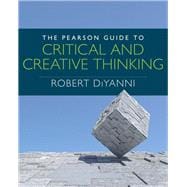Critical and creative thinking for life experience and career success
The first edition of The Pearson Guide to Critical and Creative Thinking provides students with the tools, techniques, and strategies for thinking both critically and creatively. A toolbox for higher-order analytical and imaginative thinking, readers practice critical and creative thinking by applying learned theories to examples, demonstrations, and exercises. Exercises involve both individual and collaborative critical and creative thinking applications across academic disciplines, as well as in personal and professional career contexts. The clear and easy to follow writing style makes concepts and theories accessible to all students, especially in the foundational chapters. Later chapters enable students to exercise their reasoning skills and judgment by generating ideas and applying what they’ve learned.











